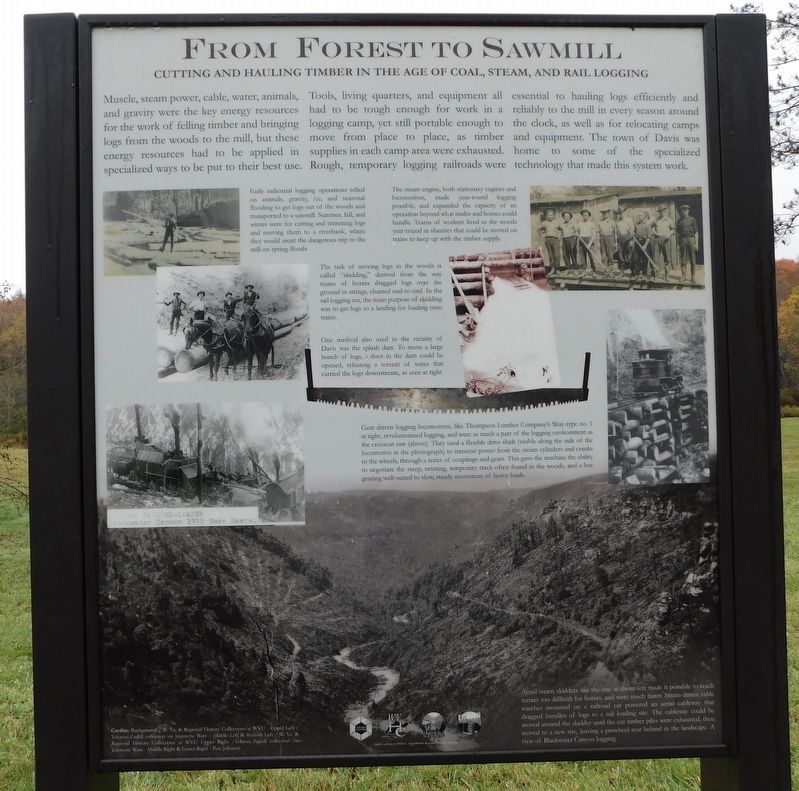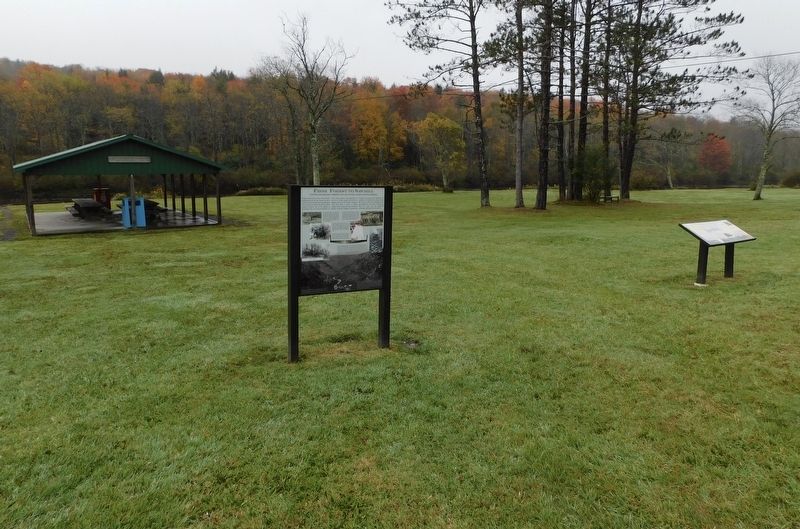Davis in Tucker County, West Virginia — The American South (Appalachia)
From Forest To Sawmill
Cutting and Hauling Timber in the Age of Coal, Steam, and Rail Logging
Muscle, steam power, cable, water, animals, and gravity were the key energy resources for the work of felling timber and bringing logs from the woods to the mill, but these energy resources had to be applied in specialized ways to be put to their best use. Tools, living quarters, and equipment all had to be tough enough for work in a logging camp, yet still portable enough to move from place to place, as timber supplies in each camp area were exhausted. Rough, temporary logging railroads were essential to hauling logs efficiently and reliably to the mill in every season around the clock, as well as for relocating camps and equipment. The town of Davis was home to some of the specialized technology that made this system work.
(Captions):
Early industrial logging operations relied on animals, gravity, ice, and seasonal flooding to get logs out of the woods and transported to a sawmill. Summer, fall, and winter were for cutting and trimming logs and moving them to a riverbank, where they would await the dangerous trip to the mill on spring floods.
The steam engine, both stationary engines and locomotives, made year-round logging possible, and expanded the capacity of an operation beyond what mules and horses could handle. Teams of workers lived in the woods year-round in shanties that could be moved on trains to keep up with the timber supply.
The task of moving logs in the woods is called "skidding," derived from the way teams of horses dragged logs over the ground in strings, chained end-to-end. In the rail logging era, the main purpose of skidding was to get logs to a landing for loading onto trains.
One method also used in the vicinity of Davis was the splash dam. To move a large bunch of logs, a door in the dam could be opened, releasing a torrent of water that carried the logs downstream, as seen at right.
Gear driven logging locomotives, like Thompson Lumber Company's Shay-type no. 1 at right, revolutionized logging, and were as much a part of the logging environment as the crosscut saw (above). They used a flexible drive shaft (visible along the side of the locomotive in the photograph) to transmit power from the steam cylinders and cranks to the wheels, through a series of couplings and gears. This gave the machine the ability to negotiate the steep, twisting, temporary track often found in the woods, and a low gearing well-suited to slow, steady movement of heavy loads.
Aerial steam skidders like the one at above left made it possible to reach terrain too difficult for horses, and were much faster. Steam-driven cable winches mounted on a railroad car powered an aerial cableway that dragged bundles of logs
to a rail loading site. The cableway could be moved around the skidder until the cut timber piles were exhausted, then moved to a new site, leaving a pinwheel scar behind in the landscape. A view of Blackwater Canyon logging.
Babcock Skidder-Loader
Blackwater Canyon 1910 Near Davis.
Credits: Background / W. Va. & Regional History Collections at WVU - Upper Left/ Tekavec-Zadell collection via Jeannette Ware - Middle Left & Bottom Left / W. Va. & Regional History Collections at WVU Upper Right /Tekavec-Zadell collection via Jeannette Ware - Middle Right & Lower Right - Pete Johnson
Layouts and text by David A. Vago Historic Resource Planning & Design
Erected 2023 by Tucker Culture, The West Virginia Humanities Council, Friends of Blackwater and Davis West Virginia.
Topics. This historical marker is listed in this topic list: Industry & Commerce. A significant historical year for this entry is 1910.
Location. 39° 7.698′ N, 79° 27.855′ W. Marker is in Davis, West Virginia, in Tucker County. Marker is on Appalachian Highway (West Virginia Route 32) south of William Avenue, on the right when traveling south. Marker is located in the Town of Davis Riverfront Park. Touch for map. Marker is in this post office area: Davis WV 26260, United States of America. Touch for directions.
Other nearby markers. At least 8 other markers are within walking distance of this marker. A Growing And Evolving Industry On The Riverbanks (here, next to this marker); Inside The Sawmill (here, next to this marker); A Prosperous Sawmill Town (a few steps from this marker); Shipping By Rail (a few steps from this marker); Myrtle Mae (Hockman) Shrader (about 300 feet away, measured in a direct line); Verzi's Saloon (about 300 feet away); The Pennsylvania House (about 300 feet away); The Blackwater Hotel (about 300 feet away). Touch for a list and map of all markers in Davis.
Credits. This page was last revised on January 5, 2024. It was originally submitted on December 5, 2023, by Bradley Owen of Morgantown, West Virginia. This page has been viewed 41 times since then and 13 times this year. Photos: 1, 2. submitted on December 10, 2023, by Bradley Owen of Morgantown, West Virginia.

